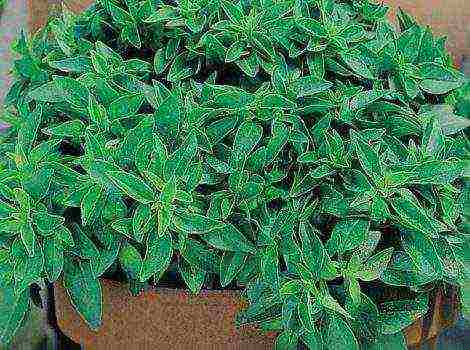Content
- 1 Long road to popularity
- 2 Photo
- 3 Capricious neighbors
- 4 Divide living space: growing cucumbers and tomatoes in one greenhouse
- 5 Useful video
- 6 Feasibility of joint landing
- 7 Selection of varieties for combined plantings
- 8 How to plant correctly?
- 9 The main features of growing cucumbers
- 10 Characteristic features of cultivation
- 11 tomatoes in greenhouses
- 12 Grow tomatoes and cucumbers together
- 13 Which "neighbor" is better for cucumbers?
- 14 Are cucumbers and tomatoes close together
- 15 How to ensure the success of joint landings
- 16 Co-Growing Gurus Tips
Long road to popularity
In any living organism, be it a plant or an animal, nature has a certain genetic code that determines its properties and requirements for the environment. 
Breeding work with seed material carried out for many decades has made it possible to change and improve the appearance and taste of vegetables.
But it is very rarely given the opportunity to change their requirements for the growing environment, although some plants can adapt to changing conditions in nature through mutational processes.
Hot India with high air humidity - homeland of cucumber... In the wild, it still grows in those places.
Images of a cucumber have been found on frescoes in Ancient Egypt and Greek temples. A vegetable known in such ancient times in other countries in Russia was first mentioned in printed sources in the 16th century.
Presumably, the cucumber came to us from East Asia, but it tasted amazingly and became a truly national product.
Bountiful harvests of cucumbers are grown in most of the country - in greenhouses and on the ground. And then, with love and diligence, cucumbers are harvested for eating all year round.
Wild tomatoes were first discovered in South America during the expedition of Christopher Columbus, and their seeds were brought to Europe because of the decorativeness of the bushes. At home, tomato thickets were found on dry and ventilated mountain slopes. The climate of those places was ideal for tomatoes - mild, temperate, with occasional heavy rains. The 24-hour temperature ranged from 20 to 25 degrees Celsius.
REFERENCE: In Holland, France and Germany, tomatoes were grown in the greenhouses of wealthy people, landed for decoration in gardens and near gazebos. Their fruits were considered poisonous. And only in 1811, the German Botanical Dictionary posted on its pages information that tomatoes can be eaten.
Tomato seeds came to Russia under Catherine II, but only at the beginning of the 19th century they began to be grown in the southern regions of the country as edible crop and get good harvests.
Photo
In the photo below you can see cucumbers and tomatoes in one polycarbonate greenhouse:
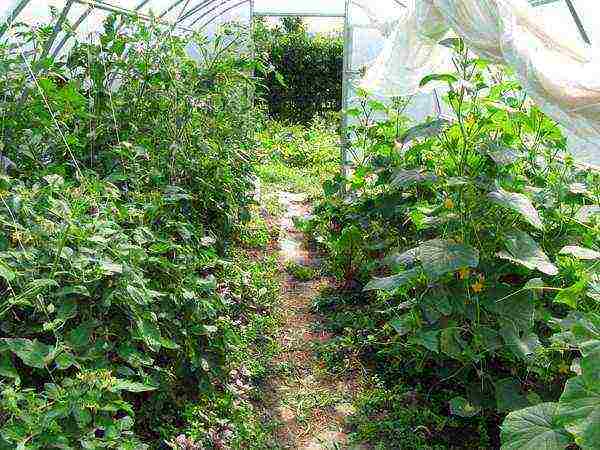
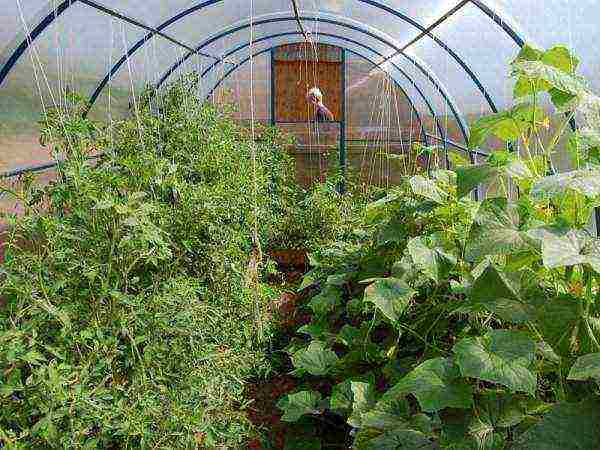
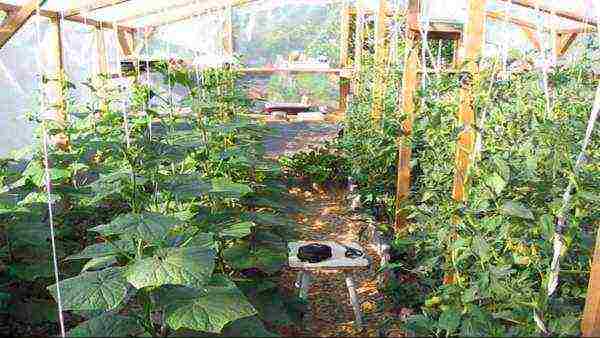
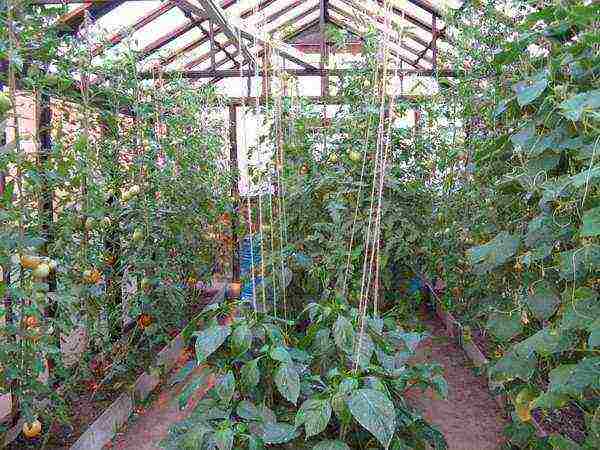
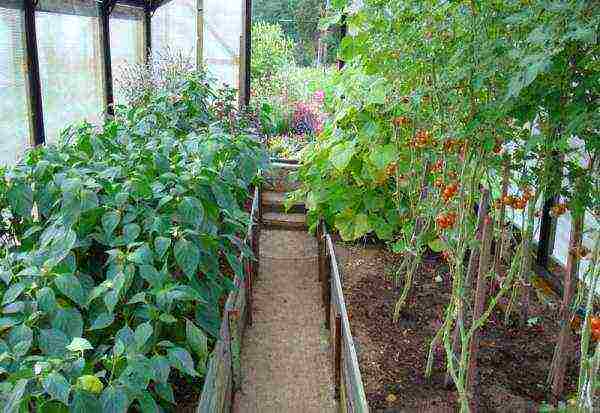
Capricious neighbors
If there is only one greenhouse, but really want to get a harvest of those and other favorite vegetables, the desire to experiment often wins. Desperate summer residents and gardeners boldly divide the greenhouse area into two adjacent zones and plant tomato seedlings on one, and cucumber seedlings on the other. What is the compatibility of cucumbers and tomatoes in the same greenhouse? Let's try to answer this question.
During the summer, both crops in a polycarbonate greenhouse receive the same care and grow in the same microclimate with the same conditions. With special diligence, the owners do not remain without a crop, but they will not have to be called abundant.
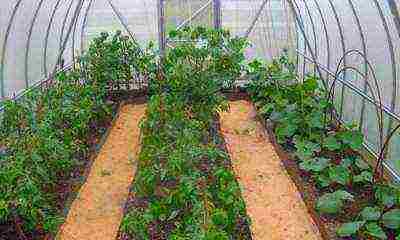 The reason for this is all the same genetics, which requires different conditions for each type of vegetables close to those in which their distant wild relatives once grew.
The reason for this is all the same genetics, which requires different conditions for each type of vegetables close to those in which their distant wild relatives once grew.
For cucumbers the optimal conditions for favorable growth will be a hot atmosphere, with high humidity, up to 90-100%.
Drafts are detrimental to this culture. Moreover, wet "bath" procedures greatly increase the yield of cucumbers. To do this, in warm weather, the bushes are well shed under the root and over the leaves, the paths and walls of the greenhouse are abundantly watered.
Then the doors are tightly closed and withstand this mode for 1-1.5 hours, after which the greenhouse is opened for ventilation. The leaves of cucumbers are very large, such procedures allow them to safely cope with the evaporation of moisture, preventing drying out.
With insufficient moisture, cucumbers grow tasteless, ugly in shape.
Tomatoes feel better in a different microclimate. Like their cousins in the wild, they prefer low humidity, 40 to 60%. They are very fond of airing.
Watering tomatoes is enough on average 2 times a week. In a too humid environment, the pollen in the flowers sticks together, the fruits in the brushes are not tied. The consequence of high humidity in the greenhouse is always the appearance of fungal and bacterial diseases of tomatoes.
The yield of vegetables decreases, the taste of the fruits deteriorates, and cracks appear on them.
With such different requirements, any compromise will mean a situation where both sides lose, so it is worth trying to change the conditions by setting up separate zones in capital greenhouses. 
Divide living space: growing cucumbers and tomatoes in one greenhouse
Divide the greenhouse into two parts you can partitions from slate, plastic curtains, plywood. Cucumbers are planted in the far "room" where the window is located. Here they will be protected from drafts, it will be possible to provide them with high humidity.
Tomatoes will be planted in the square near the greenhouse door. It is possible by keeping the door open at all times to maintain a relatively low humidity and temperature in the greenhouse.
In order to prevent water from flowing from one section to another, it will be necessary to make a barrier to separate the soil to a depth.
Now you can pamper tomato bushes with good feeding, which they love very much. This is especially true for tall varieties of tomatoes.
For cucumbers in a personal "room" abundant water treatments and high humidity are provided without much harm to neighbors. And tomatoes - generous watering with warm water, strictly under the root, avoiding contact with the leaves.
For lovers of the process itself, working with plants, planting tomatoes and cucumbers in a greenhouse will bring pleasure even if the vegetable harvest is not huge.
The most important thing is that with any method, there will be pimpled green cucumbers and poured raspberry tomatoes in the basket.
ATTENTION: Experienced gardeners, determined to get the best yield possible, will adhere to strict rules to create optimal conditions for each crop. They will grow all vegetables in a separate greenhouse, unless they need the same environment for growth. For example, the same cucumbers and bell peppers or melon. Or tomatoes and various green vegetables.
So, is it possible to plant cucumbers and tomatoes in a greenhouse? The answer to the question of how to plant, when to plant, as well as the decision of which method of growing cucumbers and tomatoes in a greenhouse to choose, whether it will be joint or not, remains the right of every gardener. If fussing in the garden is more desirable than the opportunity to get more harvest - experiments are just for you!
Useful video
A video about growing cucumbers and tomatoes in a greenhouse, see below:
The possibilities of most gardeners are significantly limited by the small area of \ u200b \ u200bplots and the presence of only one greenhouse on them, which you want to use to the maximum. Many gardeners are wondering if it is possible to plant tomatoes and cucumbers together in the same greenhouse: how harmful is such a "neighborhood" and will joint cultivation benefit these crops?
Feasibility of joint landing

Experts do not recommend growing tomatoes and cucumbers in the same greenhouse if you want to get a good harvest. It's all about the radically different needs of these crops for illumination, humidity, air quality and watering.
By creating ideal conditions for the growth of the tomato, you will stop the development of cucumbers, and vice versa. So what are the needs of these crops, and how can the atmosphere in the greenhouse be optimized so that they can grow side by side?
Cucumber needs
Cucumbers are very moisture-loving plants that require frequent and abundant watering with warm, settled water, combined with spraying the leaves. The air humidity in the greenhouse should be at least 85% - only then this capricious culture will thank you with a generous harvest.
What else do cucumbers need in a greenhouse? The optimum temperature for the development of plants and the formation of ovaries is from 22 to 28 degrees, they do not like drafts and frequent ventilation. In addition, the crop requires regular nitrogen fertilization.
So, cucumbers need constant dampness and absence of drafts, what do tomatoes need?
Needs of tomatoes

Tomatoes need diametrically opposite conditions: dampness and lack of regular ventilation will lead to the development of late blight, brown spot, gray mold and powdery mildew, which is dangerous for tomatoes.
Tomatoes are rarely watered - once a week is enough - but abundantly, while it is important to supply water to the root so that it goes directly into the ground, and does not evaporate into the air. Tomatoes do not like heat - at temperatures above 25 degrees, they noticeably slow down fruiting, which is why the greenhouse needs to be left open during the day and drafts should be arranged with the help of vents at the other end of the greenhouse.
Tomatoes do not need nitrogen fertilizers; for their normal development, other feeding is required - with the content of potassium and phosphorus.
Planting tomatoes and cucumbers in the same greenhouse leads to a rather problematic situation: trying to satisfy the needs of both crops, you thereby destroy them or reduce yields. Dampness and high humidity in the greenhouse lead to a decrease in the immunity of tomatoes and an arrest of their growth. In such conditions, tomatoes are almost always affected by late blight. In addition, the pollen becomes wet, the inflorescences are not pollinated, which means that new ovaries will not appear.
If you strive to create favorable conditions for tomatoes, this will lead to a decrease in the yield of cucumbers. Dry air, lack of constant watering, frequent ventilation and drafts cause not only a slowdown in the growth of lashes, but can also completely ruin the plant.
How to find a compromise if there is no way to plant tomatoes and cucumbers in different greenhouses? It is still possible to grow these crops together, and there are several ways to do this.
Selection of varieties for combined plantings
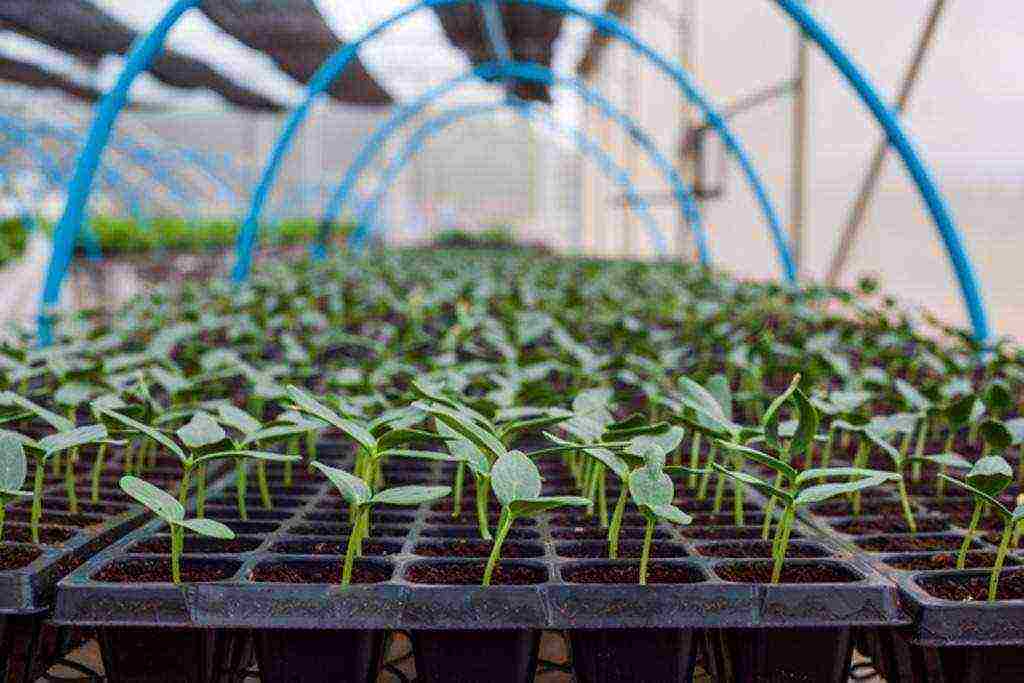
To successfully grow tomatoes and cucumbers in the same greenhouse, you should carefully choose the seed.
For joint planting, you should select such tomatoes that are resistant to late blight and are not afraid of high humidity:
- "Dubok";
- "Dubrava";
- De Barao Blacks;
- "Dwarf";
- "Lark";
- "Tsar Peter";
- "New Year";
- "Blizzard";
- Soyuz 8;
- "La la fa".
These hybrid varieties bred by agronomists and created have strong immunity and are resistant to late blight and other diseases that tomatoes are exposed to due to high humidity conditions.Of course, the selection of such seeds will not completely eliminate the problems associated with the joint cultivation of different crops, but you will have a chance to preserve all the plants and get a harvest.
In addition to buying tomato seeds protected from late blight, you should also take care of the choice of cool-resistant cucumber varieties. Insufficient air temperature can cause a whole list of specific diseases in this capricious culture - rot, powdery mildew, bacteriosis and anthracosis.
It is dangerous that these diseases can be transmitted to tomatoes, then, trying to create comfortable conditions for tomatoes, you can lose all the plants in the greenhouse and your future harvest.
Agronomists have developed a lot of varieties of cucumbers that are resistant to diseases and suitable for growing in the open field:
- "Benefit";
- "Crane";
- "Princess";
- Leandro;
- "Thumb Boy";
- "Masha";
- "Goosebump";
- "Natalie";
- Pasadena;
- "Diva";
- "Nightingale";
- "Sister Alyonushka".
By choosing such varieties and hybrids of cucumbers that are resistant to cold and diseases, you can not worry about creating a specific microclimate for plants - they can optimally transfer the ventilation of the greenhouse, which is necessary for the normal development and pollination of tomatoes.
How to plant correctly?
For optimal growth and development of neighboring crops, it is important not only to select the seed, but also to plant the plants correctly. The location of cucumbers and tomatoes in the same greenhouse requires taking into account the peculiarities of the microclimate inside the greenhouse.
Separation
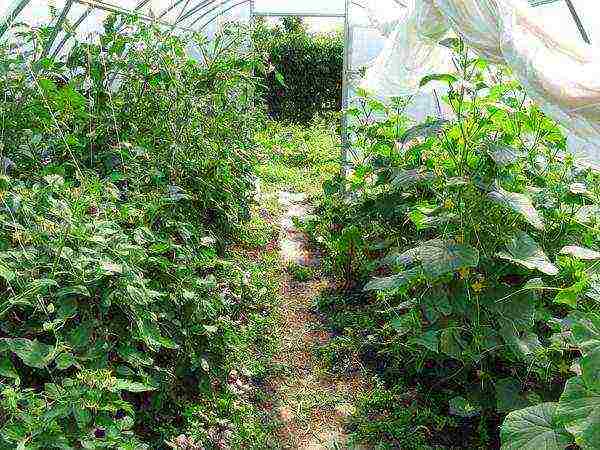
Gardeners most often use the crop separation technique when planting cucumbers and tomatoes in the same greenhouse. Their physical delimitation in the greenhouse area helps to avoid overflow of tomatoes and protects the whip from drafts.
As a rule, all greenhouses are installed in a west-east direction. This orientation provides optimal illumination of all crops from the south side.
Depending on the width of the greenhouse, 2-3 longitudinal beds are arranged in it:
- Cucumbers are planted in the northern bed. Here they will not be overdried by the sun, and the water will not evaporate so intensively into the air during irrigation.
- Tomatoes are planted in the central garden bed. There will be fresh air necessary for their comfort and pollination when ventilated.
- In the southern garden it is preferable to grow greens or eggplants. It will be too hot for tomatoes and too dry for cucumbers.
Since the soil in the greenhouse is a single whole, before planting seedlings and seed, you should attend to the demarcation of the soil. Sheets of roofing material or iron are dug in between future beds - such a measure will protect tomatoes from waterlogging with frequent watering of cucumbers and will allow you to apply fertilizers intended for each crop.
Zoning
Zoning is perhaps the most effective and optimal way to organize the space inside the greenhouse when growing different crops. This technique allows you to maintain the microclimate necessary for tomatoes and cucumbers in each part of the greenhouse.
The greenhouse is usually zoned across, dividing it into two functional parts.
There are two ways to make a partition:
- Capital method. A partition is made of cellular polycarbonate inside the greenhouse. The entrance to this compartment can be made both in the created "wall", and on the other side of the greenhouse.
- Fast way. The space inside the greenhouse can be delimited by hanging a curtain made of double-folded dense film on a stretched string or rod.
When zoning the greenhouse space, one must not forget about the separation of the soil: dig a sheet of roofing material, iron or a piece of polycarbonate of a suitable size into the ground at the border of the crops. It is recommended to put a tank with water in the "cucumber compartment" - it will not only serve for irrigation, but also additionally humidify the air in the separated area.
Hydrogel
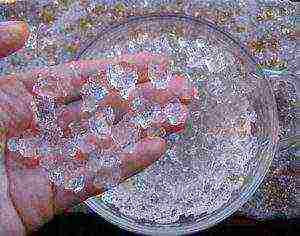 When growing tomatoes and cucumbers together, hydrogel becomes a real salvation for many gardeners.
When growing tomatoes and cucumbers together, hydrogel becomes a real salvation for many gardeners.
A modern adsorbent perfectly eliminates the problem of waterlogging of the soil and air - the crystals almost instantly absorb water during irrigation and give it to the roots of moisture-loving plants as needed.
Since water is absorbed by the hydrogel, during watering, there is no intense evaporation of moisture into the air and the humidity in the greenhouse does not increase. Thus, the use of an adsorbent does not reduce the immunity of a tomato, and at the same time provides cucumbers with the necessary liquid - both neighboring crops are comfortable.
When planting cucumber seedlings, it is enough to add about 0.5 cups of ready-made hydrogel to the hole, spill abundantly and then dig in the plant in the swollen granules. Most often, seeds are sown in a greenhouse - in this case, an organized hole with a sorbent is sprinkled with 5 cm of soil, and the prepared material is sown into the ground.
The hydrogel is convenient because it absorbs not only water, but also mineral fertilizers dissolved in it. If you soak the granules in a weak fertilizing solution before the first use, you can not worry about the nutrition of the cucumbers for a long time.
Mulch
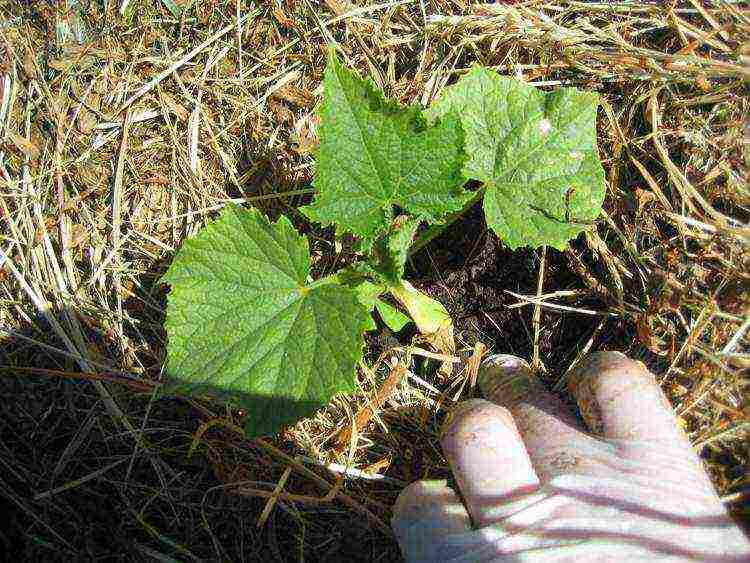
If you have already sown cucumbers in the greenhouse and it was not possible to add the hydrogel to the soil in time, you can use the mulching method. This method also helps to retain moisture at the plant roots and prevents excessive evaporation.
How to use mulch correctly:
- Prepare grass clippings or weeds that have been weeded out.
- When the seedlings sprout and the cucumbers release a real leaf, the soil around them is covered with a thick (8-10 cm) layer of mulch.
- As the layer subsides, it should be raised to the previous level of 10 cm.
Mulching allows you to reduce the number of water-loving plants, in addition, the gradually decaying lower layer releases heat, which cucumbers love so much, and nutritious organic fertilizers that are important for the development of any crop. Moisture from the soil will evaporate not into the air of the greenhouse, but under a dense mulch, creating a comfortable microclimate under each plant.
Growing cucumbers and tomatoes together in a greenhouse is undesirable, but still possible. The main thing is to divide the cultures and create for each of them the most comfortable conditions for development and fruiting.
We devote a lot of time and effort to caring for plants so that they please us with their harvest or beauty (if they are ornamental plants). We try to take into account all their whims and needs, but sometimes we have to raise them in not the best conditions. So, it has been said many times that cucumbers and tomatoes need different greenhouses. But what if you simply cannot place two greenhouses on your site? We'll have to somehow reconcile these two vegetables and teach them to live together in one greenhouse (if it's real). So is it possible to plant tomatoes and cucumbers in the same greenhouse or still not?
The fact is that each of these plants has its own requirements for humidity, lighting and ventilation, for temperature and watering, and even for fertilizers.
The main features of growing cucumbers
- Cucumbers are very moisture-loving plants.
- Watering cucumbers in the greenhouse should be frequent and abundant, not forgetting to spray the leaves. Optimum humidity should be between 85% and 90%.
- Water for watering cucumbers should be warm and, if possible, settled.
- Cucumbers are not very fond of, and they do not really need ventilation.
- The optimum temperature for growing this vegetable crop is + 200C + 220C for seedlings, and + 250C + 280C since the formation of the first ovaries.
- Cucumbers are very responsive to nitrogen fertilization. What do cucumbers need? They need a sufficient amount of moisture, which is why they are often and abundantly watered. In addition, this vegetable needs leaf spraying. That is, they love moisture, moist air and soil.
Characteristic features of cultivation
tomatoes in greenhouses
- Watering tomatoes is rarely carried out, but quite abundantly. At the same time, trying to water "at the root".
- The most favorable temperature for fruiting tomatoes is the temperature + 220С + 250С.
- Tomatoes love that the humidity of both the air and the soil is not very high. The most favorable for them is air humidity within 45% -60%... If the air humidity exceeds these values, then pollination of flowers occurs worse, and the quantity and quality of the crop is significantly reduced.
- For the normal growth and development of tomatoes, frequent and constant ventilation is necessary.
- Tomatoes are responsive to the introduction of phosphorus and potash fertilizers into the soil; nitrogen fertilizers are not as important for them as for cucumbers.
And what about tomatoes? They don't like this humidity. For tomatoes, the ideal is not 90%, as for cucumbers, but only 45-50%. If it is higher, pollination will worsen, and the harvest will be worse. And this is not to mention late blight, gray rot and powdery mildew, which will immediately appear with an increase in humidity.
Important: an increase in air humidity in the greenhouse over 60% can lead to the development of tomato diseases such as late blight, brown spot, powdery mildew and gray rot.
Important: Co-grown vegetables can be affected by common pests such as mites and whiteflies. In addition, viruses of both tomato and cucumber mosaic can be transferred from diseased plants to healthy ones through hands or untreated tools, as well as by insects such as thrips, aphids, cicadas and whiteflies.
Having considered the basic requirements for growing conditions for cucumbers and tomatoes, it becomes clear that growing tomatoes and cucumbers in one greenhouse quite problematic. Nevertheless, it is still possible to combine the incompatible, there are several options for solving this problem.
Grow tomatoes and cucumbers together
Cucumbers and tomatoes in one greenhouse The simplest and most affordable solution to the problem when cucumbers and tomatoes grow in the same greenhouse, will be simple physical separation of cultures.
Sharing cultures
The physical separation of vegetable crops such as cucumbers and tomatoes means creating the microclimate necessary for each crop. To do this, many gardeners allocate a certain part of the greenhouse for tomatoes, and fence it off from the "cucumber" part with a film or oilcloth. Thanks to this, it will be possible to control the humidity of the air when growing cucumbers and tomatoes in the same greenhouse.
Video: Growing cucumbers and tomatoes in the same greenhouse
Tomatoes and cucumbers in one greenhouse
In order to control soil moisture and fertilization applied for different crops, it is also necessary to divide the soil surface. So, between tomatoes and cucumbers, you can dig in sheets of old roofing material or iron, which will prevent excessive waterlogging of the soil in the "tomato" part of the greenhouse, and will allow you to give the required amount of water to the cucumbers.
When highlighting this or that part of the greenhouse for tomatoes, it should be remembered that they are very fond of airing. Because of this, the more vents or opening segments there are in their "compartment", the better.
So, in order to separate tomatoes and cucumbers in a greenhouse, you need:
- Make separate entrances to the "rooms" of each culture from the end sides.
- Provide a larger number of ventilation vents in the "tomato" compartment.
- Create a barrier between tomatoes and cucumbers at the soil level so that excess moisture from the cucumbers does not flow to the tomatoes.
- Hang the transparent film, from the floor to the top of the greenhouse, in order to create the optimal microclimate for each crop.
If it is supposed plant tomatoes and cucumbers in the same greenhouse, then you can plant them on opposite ridges. In this case, there will be no problems with soil moisture, and the suspended film will help withstand the air humidity required for each of the crops.
Another split option
A number of sources suggest the following method physical separation of cultures: in a greenhouse located from west to east and having two doors on opposite sides, three beds are formed:
- northern, the coolest and dampest - for cucumbers;
- central, the most ventilated - for tomatoes;
- southern, the sunniest and hottest - for peppers.
Growing three crops in one greenhouse
Which "neighbor" is better for cucumbers?
In the event that, in addition to the greenhouse, you also have a greenhouse on the site, then it may be better to plant peppers and cucumbers in the same greenhouse, and leave the greenhouse for tomatoes and eggplants.
The fact is that, like cucumbers, peppers love high humidity and air temperature, and do not often prefer to "ventilate". Like cucumbers, peppers "like" high air humidity -70%-80%, and high soil moisture, about 60% and fertilizing with nitrogenous fertilizers, although it also needs phosphorus and potassium fertilizers.
Thus, if you do not have the opportunity to "breed" tomatoes and cucumbers in different greenhouses and greenhouses, then you can grow them in one. It is only important to divide them among themselves so that each vegetable crop can grow and develop in the conditions necessary for it.
If there is both a greenhouse and a greenhouse on the site, then it is better to grow tomatoes and eggplants or watermelons in the greenhouse, and plant peppers and cucumbers in the greenhouse. That is, plants with similar needs should be combined into separate groups.
Video: Joint cultivation of tomatoes and cucumbers in a greenhouse
Joint cultivation of tomatoes and cucumbers in a greenhouse. Master gardener.
Source
Cucumbers and tomatoes get along well in salads. Is it good for them to be next to them in the garden? There is an opinion, supported by print publications and Internet resources, that growing these vegetables under one roof is contraindicated. But many gardeners-gardeners are deprived of the opportunity to build separate greenhouses for them. So those who have to be content with one greenhouse are wondering whether it is possible to plant cucumbers and tomatoes in one greenhouse and how to create a common “home” that is comfortable for different plants.
Are cucumbers and tomatoes close together
While some are thinking, taking on faith the categorical "no", others are actively getting down to business, experimenting with planting, growing vegetables and come to the conviction: "You can!". You can grow cucumbers and tomatoes in the same greenhouse, and quite successfully, you just need to try so that each crop is not particularly disadvantaged in its needs and gets everything it needs for itself.
True, this is not too simple, since the requirements of the two plants to the conditions in a closed structure do not coincide.
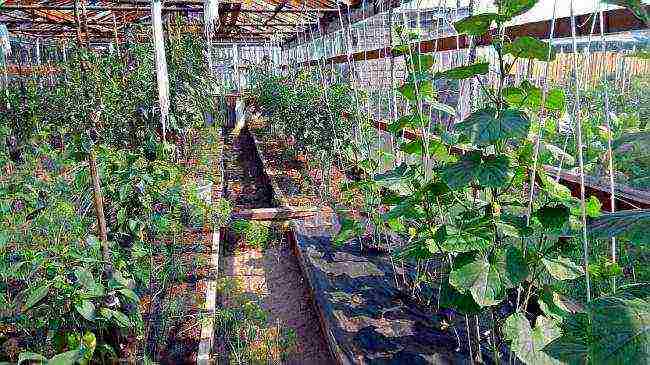
With a skillful approach to cultivation, cucumbers and tomatoes live together
Features of cultivation of tomatoes
Tomatoes for normal growth and good fruiting need:
- in low (up to 70%) air humidity;
- good ventilation of the greenhouse;
- air temperature 22-26 degrees during the day, not lower than 19 degrees at night;
- sufficient illumination;
- feeding with phosphorus-potassium fertilizers;
- mandatory prevention of possible diseases, pest control.
Dry air is vital for greenhouse tomatoes. High humidity is a path to bacterial and fungal diseases (late blight, gray rot, brown spot, etc.). In addition, humid air causes the pollen of tomato flowers to clump together - they do not pollinate and form ovaries.
To maintain the concentration of moisture in the air within the required limits, frequent through ventilation of the greenhouse and proper organization of watering of plants are required.
Temperature is no less important for the development of tomatoes. At low temperatures, fruit formation is delayed. And if the temperature exceeds 30 degrees, the formation of ovaries does not occur at all, since the pollen becomes sterile. Good ventilation (airing) of the greenhouse allows you to regulate the air humidity in it, and partly its temperature.During warm nights, you can leave all doors and transoms open so that both of these parameters are normal.

Tomato Draft for Joy
Watering requirements:
- Watering tomatoes is not required very often (in normal, not dry weather, once a week), but abundantly, shedding the soil to a depth of about 20-25 cm, since their roots go quite deep.
- Sprinkling tomatoes is unacceptable.
- Watering with warm water should be done at the root, around the stem, avoiding moisture on the bush itself.
- It is better to water it in the morning (in the extreme case - until the middle of the day) in order to significantly reduce the humidity by the evening.
- The ideal option is underground watering.
To determine if it is possible to plant and grow cucumbers and tomatoes in the same greenhouse, you also need to know what cucumbers love.
Requirements for growing cucumbers
Cucumbers feel comfortable in providing:
- high level (up to 100%) air humidity;
- temperatures 26-28 degrees during the day;
- lack of drafts;
- good illumination;
- dressing with a predominance of nitrogen;
- disease prevention, pest control.
Probably the last item on this list is the only thing that unites an emerald vegetable with a red (yellow, orange, etc.) fellow. And even then, diseases and pests are different for the most part.
Insufficient humidity of the air and soil negatively affects the development of the cucumber. Its roots are shallow. And although they grow quite widely around the stem, with insufficient soil moisture, the roots are unable to water a huge above-ground part of the plant, sometimes 200 times the mass of the root system.

Cucumbers feel comfortable without drafts
Large leaves of cucumbers actively evaporate a lot of moisture, creating almost one hundred percent air humidity in the borage. On hot days, so that the leaves do not wither, these vegetables need to be watered with warm water every other day, or even daily. The existing opinion that the plants should be sprayed on the leaves is doubtful: this procedure can cause some diseases of cucumbers (especially with a thickened planting).
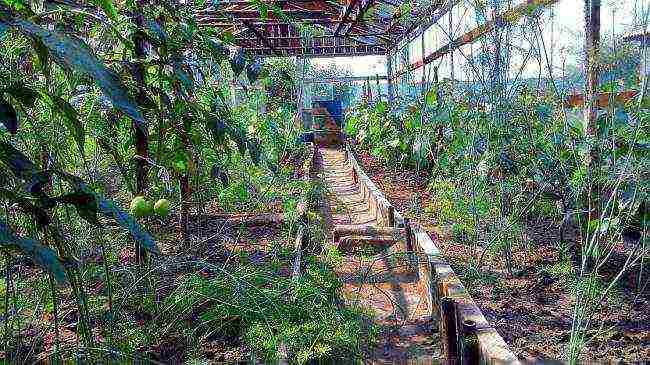
A barrel under the roof serves as a reservoir for warm irrigation water
In hot weather, it is better to arrange a "bath" for cucumbers: pour the soil under the plants, paths, garden beds from a watering can, then completely close the greenhouse for about an hour. After such a steam room, cucumbers grow well, which cannot be said about tomatoes. They will certainly get sick from such events: high humidity is the main enemy of the "senior tomato".
So, give up the thought of raising your favorite pets together? Or is it still possible to find a solution to how to plant tomatoes and cucumbers in the greenhouse so that they do not experience stress and please with the harvest?
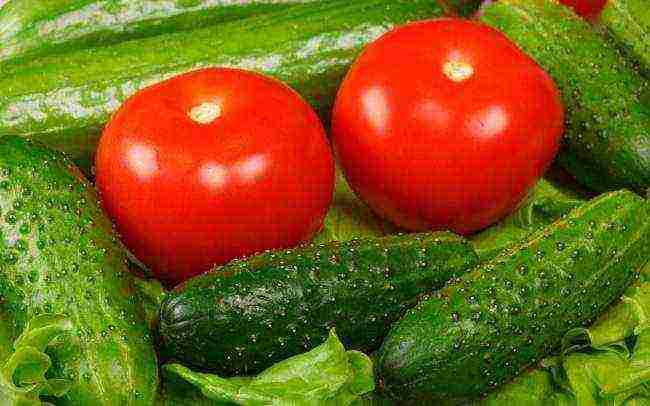
It is quite possible to grow healthy tomatoes and cucumbers in the same greenhouse.
How to find a compromise
The listed differences, it would seem, are weighty arguments: if you want to feast on tomatoes and cucumbers to your heart's content, build a second greenhouse on the site. Another option is to grow one of the crops outdoors, using temporary shelters in the spring. Indeed, it would be ideal to grow vegetables so different in their needs in individual stationary shelters. Undoubtedly, the quantity of the crop in this case would be greater, and the quality is higher.
However, if getting record yields is not your goal, moreover, the funds do not allow you to purchase another greenhouse, you can experiment with the cultivation of cucumbers and tomatoes planted together. Having adopted the rich experience of practicing gardeners, it is not too difficult to achieve a completely acceptable yield, sufficient to provide a family with vegetables.
How to ensure the success of joint landings
Looking for an answer to the question of whether it is possible to plant cucumbers and tomatoes, and peppers, too (not to mention various greens) in the same greenhouse, you should not go far.
Many years of experience in home plant growing in the conditions of small summer cottages and the cramped material conditions of the owners led to the development of principles for joint planting.
This experience proves that it is possible to create some average conditions for a fairly comfortable joint cultivation of a wide variety of vegetables.
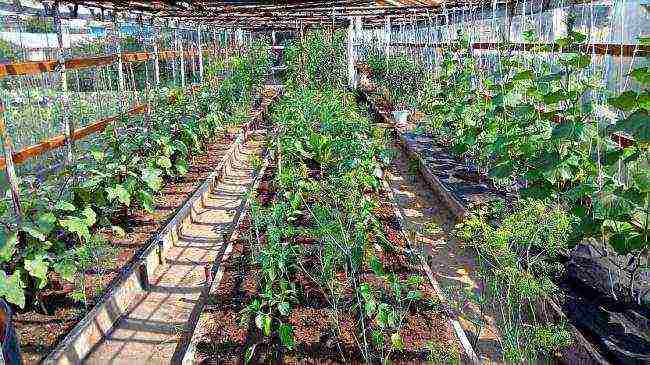
Eggplants, peppers, cucumbers, dill, tomatoes coexist peacefully in one greenhouse
Which culture to please more when planting together
The analysis of the growing conditions for cucumbers and tomatoes showed that they differ significantly.If, when growing together, you give preference to tomatoes, cucumbers will suffer somewhat from the dry air. But it is worth noting that if they do not like such an atmosphere, they will still withstand it, although they will not be as luxurious as in a “personal” greenhouse.
If the humidity and temperature in the greenhouse are maintained to please the cucumbers, the tomatoes will cease to bear fruit, and their mass diseases will begin. However, you can try to choose some average indicators in order to provide more or less acceptable conditions for both plants.
The temperature favorable for the fruiting of cucumbers is 25-28 degrees, for tomatoes it is 22-25 degrees. It is worth choosing a temperature of 25 degrees, which will suit both vegetables.
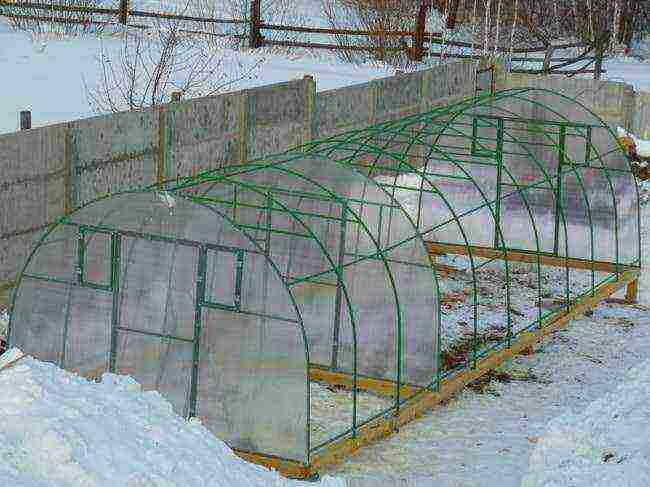
Greenhouse frame with partitions
Tomatoes start to hurt when humidity is over 70%. If it is maintained below this value, cucumbers will tolerate it, although without pleasure. Contrary to the generally accepted judgment, they are also not too afraid of airing, and the often recommended stagnant, stuffy air leads to diseases not only of tomatoes, but also of cucumbers.
But the requirements of these plants for watering when grown on the same bed cannot be combined. When deciding how to plant cucumbers and tomatoes in a greenhouse, you have to think about plant separation. A reasonable layout will help solve this problem.
How to properly divide vegetables in a greenhouse facility
Without a doubt, the structure used for the joint planting of vegetables that need different conditions for their growth should be spacious enough. There should be room in the greenhouse for the beds and for comfortable, wide aisles between them. Otherwise, the issue of dividing cultures may become unsolvable: a bunch of small ones will not bear fruit, but will only become a “headache” for the owner.
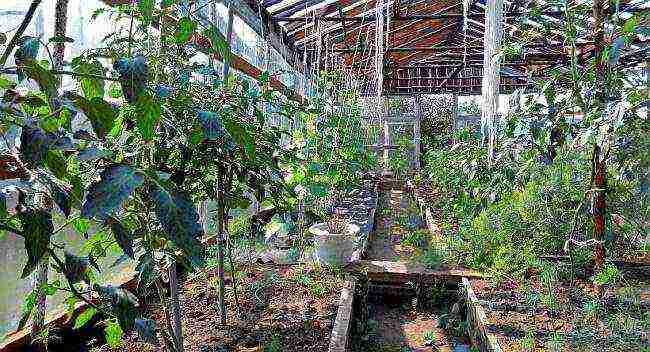
The spacious greenhouse is easy to place and divide plants
When growing different crops together in a garden under a roof, it is important to carefully consider the location of the ridges and plants on them. The goal is to allocate zones for each vegetable and to provide everyone with the most comfortable life in the cell of the greenhouse community with its own microclimate.
It is more rational to place the beds in the greenhouse along the long sides. Depending on the width of the structure, 2 ridges can be provided on the sides of the central passage, 3 equal in width or a wider ridge in the middle and 2 narrow ones on the sides. The latter option seems to be the most convenient for separating vegetables and caring for them.
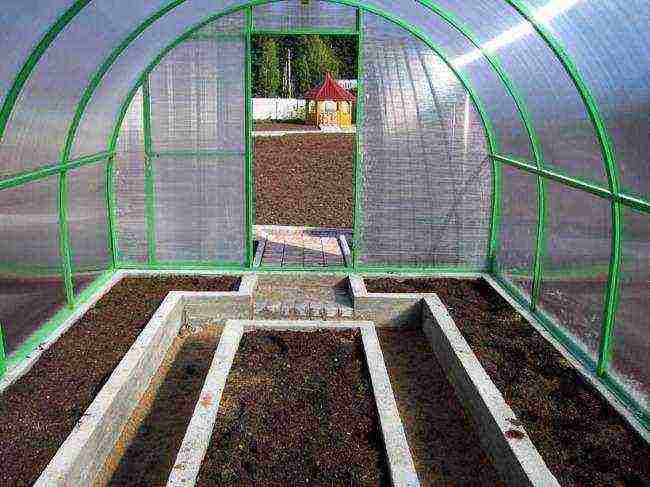
Rational placement of beds
In such a greenhouse, stretched from west to east, with 2 doors at the ends, it would be reasonable to plant vegetables like this:
- to take away the northern - cooler and wetter beds for cucumbers;
- place tomatoes on the central, most ventilated;
- give the south side to sun-adoring peppers (eggplants).
To separate cucumbers and tomatoes in a greenhouse, the long sides of which are facing west and east, it is necessary:
- Place cucumbers in one half of a warm garden, tomatoes in the second half. For peppers who love infrared light, take a place at the western wall.
- Hang a transparent film from the floor to the ground between the tomato and cucumber compartments, or install a partition.
- At ground level between cucumbers and tomatoes, make a waterproof barrier by digging in an old sheet of iron or roofing material. This will allow you to drink cucumbers to your heart's content, without fear of waterlogging the soil under the tomatoes.
- Provide a maximum of air vents in the tomato part of the greenhouse.
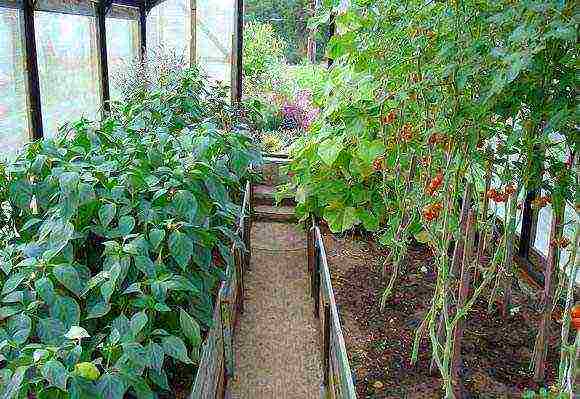
Separation of plants in a structure with a north-south orientation
Selection of varieties for combined plantings
Before starting growing plants in combined plantings, it makes sense to take care of the correct selection of varieties. After examining the catalogs of stores, you can choose varieties of tomatoes that are not afraid of moisture, resistant to late blight. It is also quite realistic to pick up seeds of cucumbers, not particularly demanding for watering, easily tolerating drafts.Thanks to this, vegetables will already be more adapted to coexistence.
In the process of choosing cucumber seeds, you should pay the greatest attention to high-yielding parthenocarpic hybrids, preferably with a bouquet ovary and good branching.
It is better if the selected variety is short-growing, then the growing vines will not interfere with each other and other plants growing nearby, and will not block the aisles. There will be less hassle when cultivating cucumbers of this variety with a pinch, which is required for most varieties.
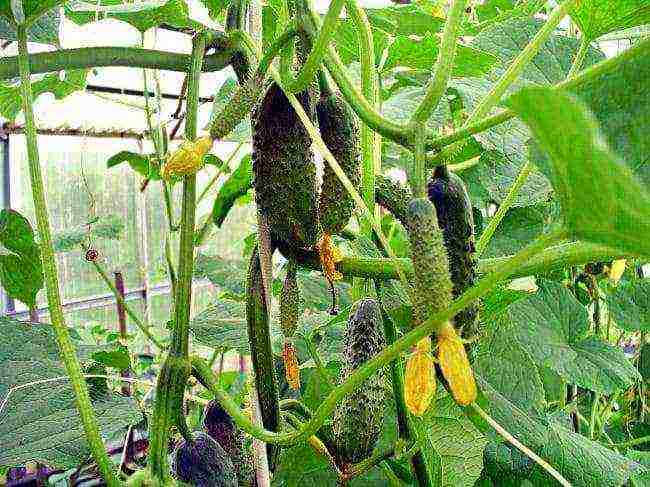
Pace F1 is one of the best hybrids
If the greenhouse is not high, and it is planned to harvest green plants from the side ridges, you should opt for hybrids with short internodes and form them correctly. And for a greenhouse, standing close to trees and buildings, shade-tolerant hybrids are suitable. In a word, faced with the problem of how to plant cucumbers and tomatoes in a greenhouse together, the choice of a variety must be carried out, taking into account the conditions on the site as much as possible.
When choosing tomato seeds, it is better to also focus on hybrids. Tall indeterminate hybrids will be suitable for the central bed. When planting tomatoes in an arched structure on a side bed, determinant hybrids may be more suitable. In any case, you will need to avoid thickening the plantings, pay maximum attention to the formation of bushes.
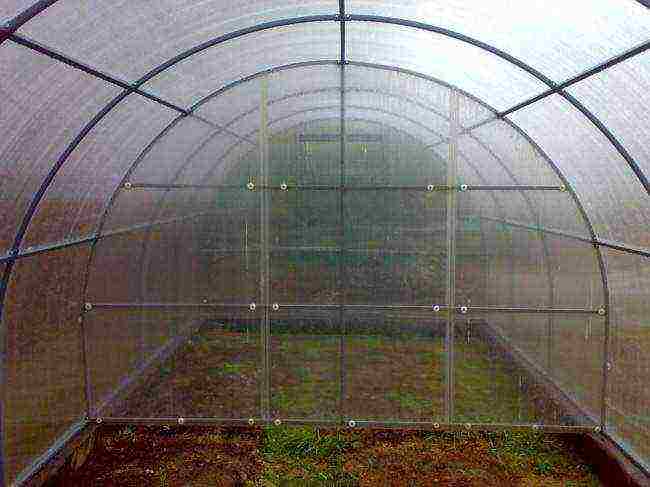
Modern greenhouse with split bed divider
Glass or polycarbonate - perfect cover
Practical, reliable, easy-to-install greenhouses covered with cellular polycarbonate are rapidly displacing their glass predecessors from the sites. Which of these greenhouse structures is better suited for the joint cultivation of various vegetables? Apart from other advantages and disadvantages, it should be noted that the ventilation of glass greenhouses is undoubtedly better.
This makes it possible to provide tomatoes with more comfort when planting together. In polymer greenhouses, they suffer more from excess air moisture. However, a lot depends on the design.
The device of partitions and a sufficient number of vents in modern structures allows you to cultivate cucumbers and tomatoes in one polycarbonate greenhouse no less successfully than in a glass one. Additionally, peppers, eggplants, greens can be grown together with them.
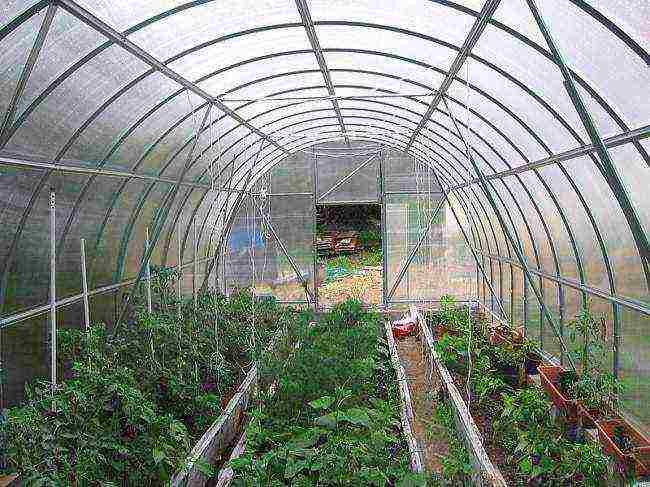
Cucumbers, peppers, tomatoes in a polymer greenhouse
Co-Growing Gurus Tips
In gardening, nothing compares to the usefulness of many years of experience. The topic of how to plant tomatoes, cucumbers, eggplants, peppers and other plants in one greenhouse is given much attention in his articles and books by G.A.Kizima, a gardener-practitioner with half a century of experience. She shares her personal experience on the successful joint cultivation of greenhouse vegetables.
Working tips from a practitioner
Galina Aleksandrovna is convinced (it is worth agreeing with this) that the airing of the greenhouse must be organized according to the requirements of the tomatoes, and this will not harm the cucumbers. And the needs of the latter in moisture should be satisfied as follows.
- When planting a green vegetable, use a hydrogel, a bag of which is enough for 30 plants.
- When planting, place ½ cup of ready-made gel in the holes and plant seedlings directly on it. When planting with seeds, the hydrogel must first be sprinkled with earth with a layer of 4-5 cm.
- Soaking the hydrogel instead of water in a weak solution of the preparations "Fitosporin" and "Gumi" can at the same time provide feeding of cucumbers and protect them from diseases.
- In the absence of a hydrogel, care should be taken to mulch the soil under the cucumbers with a layer of cut grass or weeded out weeds, maintaining the layer thickness (8-10 cm) constantly.

The closer the neighborhood, the more difficult it is for the gardener
Advantages of the method of a renowned vegetable grower
The implementation of these measures will make it possible to water cucumbers much less often, since moisture will evaporate less from the soil.With this evaporation, the plants will receive the humid microclimate they require, but the total humidity in the greenhouse will not increase, which is important for tomatoes. In addition, decomposing, the lower part of the mulch will supply the roots of the cucumbers with additional nutrition.
As for the intricacies of growing tomatoes together with cucumbers, G.A.Kizima recommends:
-
when planting, add a handful of feathers to the hole - this will supply the tomatoes with silicon, which will increase their resistance to disease;
-
do not break off the central root when planting, so that the roots of the tomato roll inward, finding moisture for themselves;
-
to retain moisture in the soil, preserve drier air under the tomato bushes, mulch the ground under the plants with newspapers, folding them in several layers.
You have learned about some of the aspects of co-growing plants in greenhouses. Based on the recommendations outlined here, you will be able to make the most of your “roofed garden”. However, additional information may be required. Read articles, books, consult with experts, learn from the invaluable experience of practitioners, and everything will work out.

